Boletus L.
Recent molecular studies have shown that Boletus in its current circumscription is likely an artificial grouping and it is possible that it will be split at some point into smaller genera. Note that Boletus impolitus and Boletus depilatus for practical reasons are retained here, although there is strong evidence that they are closely related to Xerocomus subtomentosus and its allies.
Fruitbody large to medium sized, boletoid, without veil and ring. Stipe solid, with surface usually covered with granules or network. Flesh variously coloured, changing or not when exposed to air. Tubes easily separable from each other, not tearing apart. Pores usually small and rounded.
Boletus legaliae Pilát
Description
Cap up to 12 cm, at first hemispherical, later convex to flat-convex or almost flat, initially finely velvety, then smooth, at first almost white, greyish to dark grey, greyish brown, ochraceous or beige, with pinkish tint at the cap margin, later beige with irregular pink or vinaceous spots, often entirely dingy pink, dark pink or pinkish vinaceous. Stipe club-shaped or cylindrical, in the uppermost part bright to dark yellow, downwards orange red to red or pinkish red, with fine orange red or red network, in the lower pat with fine red or pinkish red granules, stipe surface blueing when handled. Flesh pale yellow, sometimes with reddish spots in the stipe base, blueing when exposed to air. Tubes yellow, blueing when injured. Pores red to orange, blueing when bruised. Smell of hay, persistent when the fungus is dried. Taste slightly acid. Spores 9–15 × 4–6 μm, ratio 1.9–3. Pileipellis trichodermium of interwoven septate hyphae of cylindrical, finely incrusted cells. Chemical reactions: hyphae of the flesh in the stipe base amyloid with Melzer’s solution.
Habitat. Warm broadleaf forests, mycorrhizal with oaks (Quercus) or beech (Fagus).
Distribution. In Europe widespread but uncommon, more often encountered in south.
Similarity. Boletus rubrosanguineus is very similar, but is found under conifers. Boletus rhodoxanthus is also similar; it is distinguished on the account of its yellow flesh which blues mostly in the cap and remains unchanged in the stipe. Compare also with Boletus satanas, although the later usually has different cap colour.
Photographs

An ample collection of fruitbodies of Boletus legaliae in different stages of development. (photo G. Kibby)
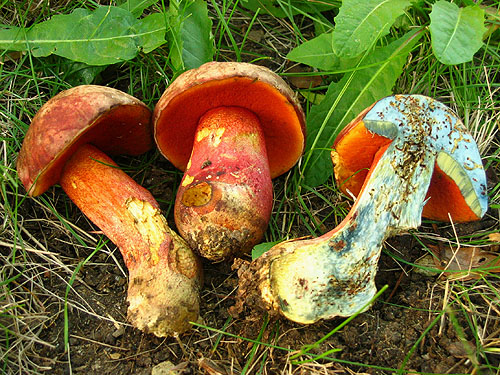
Well developed fruitbodies of Boletus legaliae (photo B. Assyov)
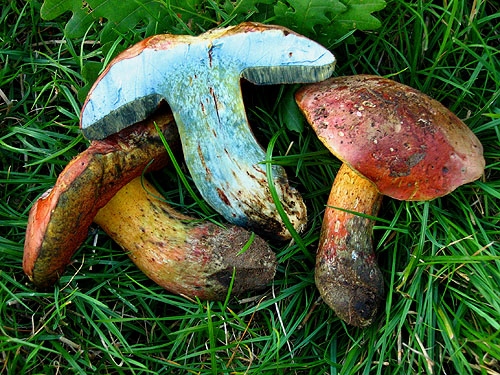
Well developed fruitbodies of Boletus legaliae (photo B. Assyov)

Young and well developed fruitbodies of Boletus legaliae (photo B. Assyov)
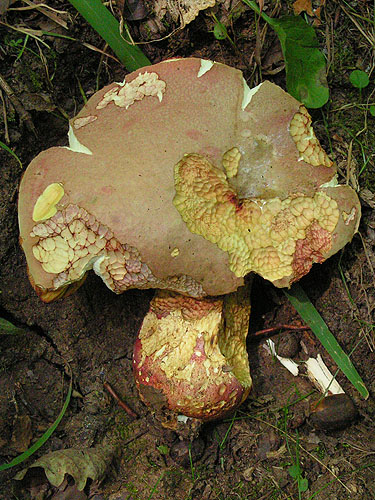
Well developed fruitbodies of Boletus legaliae. Note the colour variability. (photo B. Assyov)

Very young fruitbody of Boletus legaliae. Note the white cap colour. (photo B. Assyov)
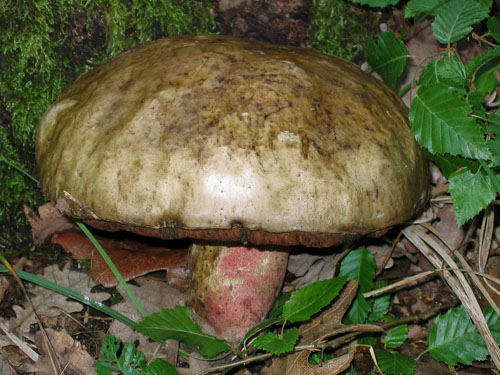
Old fruitbody of Boletus legaliae. Note the overall fading of colours. (photo B. Assyov)
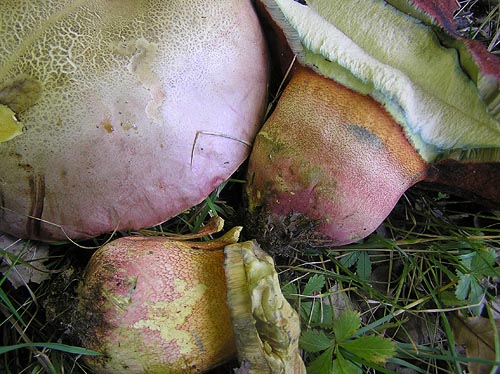
Fruitbodies of Boletus legaliae. The network may vary significantly in this species and may sometimes resemble the network pattern in Boletus rhodoxanthus as seen on the fruitbody on the right. (photo H.G. Toresson)

Detail of the stipe of Boletus legaliae. Note the network and the granulated lower part. (photo B. Assyov)
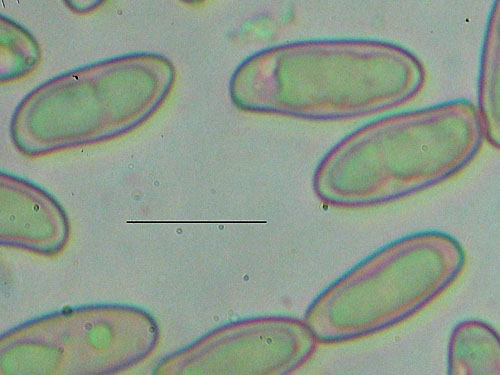
Boletus legaliae - spores. Scale bar = 10 μm. (photo B. Assyov)
Important literature
Alessio, C.L. 1985. Boletus Dill. ex L. (sensu lato). – In: Fungi Europaei. Vol. 2. Pp. 1–705. Libreria editrice Biella Giovanna, Saronno.
Anderson, M. 2013. A rare bolete, Boletus legaliae, in the Royal Garden of Drottningholm, Stockholm. Svensk Mykologisk Tidskrift 34(3): 9-13. (available online with supplementary materials)
Breitenbach J. & Kränzlin F. 1991. Pilze der Schweiz. Bd. 3(1). Röhrlinge und Blätterpilze. Verlag Mykologia, Luzern.
Engel, H., Krieglsteiner, G., Dermek, A. & Watling, R. 1983. Dickröhrlinge. Die Gattung Boletus in Europa. Verlag Heinz Engel, Weidhausen b. Coburg.
Estadès, A. & Lannoy, G. 2004. Les bolets européens. – Bulletin Mycologique et Botanique Dauphiné-Savoie 44(3): 3–79.
Galli, R. 1998. I Boleti. Atlante pratico-monographico per la determinazione dei boleti. Edinatura, Milano.
Knudsen, H. & Vesterholt, J. [eds.]. 2008. Funga Nordica. Nordsvamp, Kopenhagen.
Lannoy, G. & Estadès, A. 2001. Les Bolets. Flore mycologique d’Europe. Documents Mycologiques Mémoire Hors série no. 6. Pp. 1–163. Association d’Écologie et de Mycologie, Lille.
Muñoz, J.A. 2005. Boletus s. l. – In: Fungi Europaei. Vol. 1. Pp. 1–951. Edizioni Candusso, Alassio.
Pilát, A. & Dermek, A. 1974. Hríbovité huby. Československé hríbovité a sliziakovité huby (Boletaceae – Gomphidiaceae). Veda, Bratislava.
Šutara, J., Mikšík, M. & Janda, V. 2009. Hřibovité houby. Čeled’ Boletaceae a rody Gyrodon, Gyroporus, Boletinus a Suillus. Academia, Praha.
Watling, R. & Hills, A.E. 2005. Boletes and their allies (revised and enlarged edition). – In: Henderson, D.M., Orton, P.D. & Watling, R. [eds]. British Fungus Flora. Agarics and boleti. Vol. 1. Royal Botanic Garden, Edinburgh.